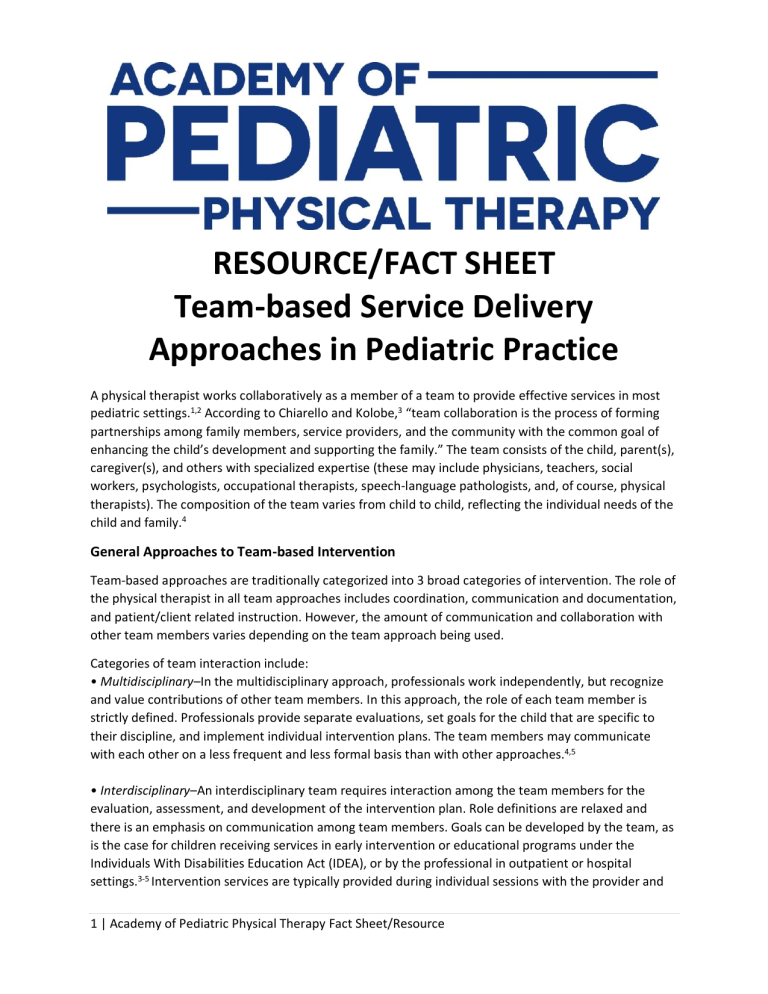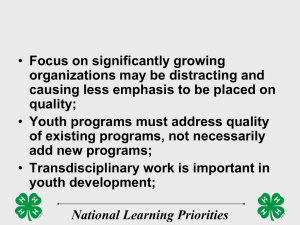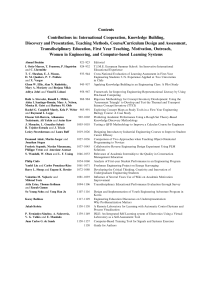
RESOURCE/FACT SHEET Team-based Service Delivery Approaches in Pediatric Practice A physical therapist works collaboratively as a member of a team to provide effective services in most pediatric settings.1,2 According to Chiarello and Kolobe,3 “team collaboration is the process of forming partnerships among family members, service providers, and the community with the common goal of enhancing the child’s development and supporting the family.” The team consists of the child, parent(s), caregiver(s), and others with specialized expertise (these may include physicians, teachers, social workers, psychologists, occupational therapists, speech-language pathologists, and, of course, physical therapists). The composition of the team varies from child to child, reflecting the individual needs of the child and family.4 General Approaches to Team-based Intervention Team-based approaches are traditionally categorized into 3 broad categories of intervention. The role of the physical therapist in all team approaches includes coordination, communication and documentation, and patient/client related instruction. However, the amount of communication and collaboration with other team members varies depending on the team approach being used. Categories of team interaction include: • Multidisciplinary–In the multidisciplinary approach, professionals work independently, but recognize and value contributions of other team members. In this approach, the role of each team member is strictly defined. Professionals provide separate evaluations, set goals for the child that are specific to their discipline, and implement individual intervention plans. The team members may communicate with each other on a less frequent and less formal basis than with other approaches.4,5 • Interdisciplinary–An interdisciplinary team requires interaction among the team members for the evaluation, assessment, and development of the intervention plan. Role definitions are relaxed and there is an emphasis on communication among team members. Goals can be developed by the team, as is the case for children receiving services in early intervention or educational programs under the Individuals With Disabilities Education Act (IDEA), or by the professional in outpatient or hospital settings.3-5 Intervention services are typically provided during individual sessions with the provider and 1 | Academy of Pediatric Physical Therapy Fact Sheet/Resource child; however, providers sometimes perform co-visits or group interventions to facilitate coordination and communication among team members. • Transdisciplinary–In the transdisciplinary approach, team members provide joint evaluations and work together to develop goals and carry out interventions. This approach calls for one team member, often referred to as the primary provider, to be the individual that the family interacts with on a regular basis. This provider implements the intervention plan and receives consultation from other providers. In some cases, the other providers will co-visit with the primary provider for a defined length of time to refine the intervention plan. In most transdisciplinary approaches, the primary provider is based on the child’s and family’s current needs and concerns and the amount of consultation is based on the child’s and family’s need and the primary provider’s knowledge base. When a team functions in a transdisciplinary fashion, the primary provider can change as the child’s and family’s needs change. In this team approach, physical therapists share aspects of their discipline and learn aspects of other team members’ disciplines. This sharing of information and professional competencies is called “role-release.” Team members must actively strive to communicate, collaborate, and cross disciplinary boundaries more frequently than with other approaches.3,5-9 Within the transdisciplinary approach, Rush, Shelden, and Hanft10 describe a primary coach approach to teaming where a single, long-term service provider is assigned as the primary coach to the family or caregivers. This provider helps implement strategies to achieve all outcomes, with support and consultation from other team members. In this approach, the primary coach usually does not change as the child’s and family’s needs change. Essential Elements of Teaming Each team approach described above has unique characteristics that help define the foundational framework for team interaction. No matter what team approach is implemented, key components are consistently identified as essential for successful team collaboration and outcomes.11-13 A successful collaborative team environment includes: • A shared framework of trust • Clearly defined roles and responsibilities • Respectful and empathetic open communication • Appreciation of diversity • Equal participation among all team members • Established common goals • Consensus decision making12 • Solution-focused problem solving • Ongoing evaluation • Strong leadership13 Even though collaborative teaming is valued, when team members are working under busy schedules, communication can easily break down and coordinating services can become a challenge. Open and frequent communication is essential among all team members, including parents and caregivers. Team members should have planned times to meet—either in person, by phone, or by email—at regular intervals to discuss care plans. If team members do not discuss care plans frequently, they miss out on opportunities to share and listen to challenges that they are encountering or progress the child is making, which can affect decisions regarding intensity and nature of physical therapy and other services.4 2 | Academy of Pediatric Physical Therapy Fact Sheet/Resource Recommended Practices The choice of team approach should be based on the needs of the child and family.14 The recommended—and generally accepted—approaches of teaming are interdisciplinary and transdisciplinary.1,6 However, there has been a recent shift toward the recommendation and use of transdisciplinary teaming, particularly in early intervention settings.5,8 The Division of Early Childhood (DEC) recommends in DEC Recommended Practices in Early Intervention/Early Childhood Special Education15 that team members use a transdisciplinary model to plan and deliver interventions. Taken literally, physical therapists would have legal and ethical concerns practicing in a transdisciplinary model and "releasing" aspects of their discipline. However, in 1997, Rainforth16 found that—although delegation is not allowed for evaluation, intervention planning, and supervision—role release and delegation of intervention strategies can be both ethical and legal and exist within the scope of physical therapy practice (the American Physical Therapy Association’s Guide to Physical Therapist Practice17 provides instruction for coordinating, communicating, and documenting patient/client-related interventions). In other words, physical therapists may teach others activities or intervention strategies that do not require the expertise of the physical therapist. Role release was described by Lyon and Lyon18 as the deliberate process of sharing information and skills and was conceptualized as occurring across multiple levels.19 It is important that the family and other team members understand that when performing the activities that the physical therapist taught them, they are implementing specific activities to support their child’s development, not providing physical therapy.4 In summary, the descriptions of the approaches of team-based service delivery should be considered a continuum that is based on communication among team members and a number of professionals working directly with the child and/or family. Advantages and limitations exist for each of the approaches. References 1. Chiarello L, Effgen S. Updated competencies for physical therapists working in early intervention. Pediatr Phys Ther. 2006;18(2):148-158. 2. Effgen S, Chiarello L, Milbourne S. Updated competencies for physical therapists working in schools. Pediatr Phys Ther. 2007;19(4):266-274. 3. Chiarello L, Kolobe T. Early intervention services. In: Campbell SK, Vander Linden DW, Palisano R, eds. Physical Therapy for Children. 3rd ed. St. Louis, MO: Saunders Elsevier: 2006. 4. Vanderhoff M. Maximizing your role in early intervention. APTA Web site. http://www.apta.org/AM/Template.cfm?Sectio n=Home&TEMPLATE=/CM/HTMLDisplay.cfm&C ONTENTID=8534. Accessed on February 24, 2010. 5. Effgen S. Serving the needs of children and their families. In: Effgen S, ed. Meeting the Physical Therapy Needs of Children. Philadelphia, PA: F. A. Davis Company; 2006. 6. Bohmert J. Physical therapy in the educational environment. In: Connolly B, Montgomery P, eds. Therapeutic Exercise in Developmental Disabilities. Thorofare, NJ: SLACK Inc; 2005. 7. Effgen S. The educational environment. In: Campbell SK, Vander Linden DW, Palisano R, eds. Physical Therapy for Children. 3rd ed. St. Louis, MO: Saunders Elsevier; 2006. 8. Rapport MJ, Eigsti H. Planning, coordinating, 3 | Academy of Pediatric Physical Therapy Fact Sheet/Resource and implementing early intervention services. Presented at: The IDEA Part C Early Intervention Programs: Implementing Recommended Competencies for Physical Therapists course. Denver, CO: 2009. 9. King G, Strachan D, Tucker M, et al. The application of a transdisciplinary model for early intervention services. Infants Young Child. 2009;22(3):211-223. 10. Rush D, Shelden ML, Hanft B. Coaching families and colleagues: a process for collaboration in natural settings. Infants Young Child. 2003;16(1)33-47. 11. Briggs MH. Building Early Intervention Teams: Working Together for Children and Families. Rockville, MD: Aspen; 1997. 12. Rainforth B, York-Barr J. Collaborative Teams for Students With Severe Disabilities. 2nd ed. Baltimore, MD: Paul M. Brookes; 1997. 13. Utley B, Rapport MJ. Essential elements of effective teamwork: shared understanding and differences between special educators and related service providers. Phys Disabilities: Educ Related Services. 2002;20(2):9-47. 14. Mullins LL, Balderson B, Sanders N, Chaney J, Whately P. Therapists' perceptions of team functioning in rehabilitation contexts. Int J Rehabil Health.1994;3(4):281-288. 15. Sandall S, McClean ME, Smith B. DEC Recommended Practices in Early Intervention/Early Childhood Special Education. Longmont, CO: Sopris West; 2000. 16. Rainforth B. Analysis of physical therapy practice acts: implications for role release in educational environments. Pediatr Phys Ther. 1997;9(2):54-61. 17. American Physical Therapy Association. Guide to Physical Therapist Practice. Alexandria, VA: American Physical Therapy Association; 2004. 18. Lyon S, Lyon G. Team functioning and staff development: a role release approach to providing integrated educational services for severely handicapped students. J Assoc Severely Handicapped. 1980;5(3):250-263. 19. Utley B, Rapport MJ. Exploring role release in the multidisciplinary team. Phys Disabilities: Educ Related Services. 2000;18(2):89-119. There are numerous Web sites and publications available on this subject; this list is not meant to be all inclusive. Many of the listed sites have links to additional resources. ©2010 by the Academy of Pediatric Physical Therapy, American Physical Therapy Association, 1111 N Fairfax Street, Alexandria, VA 22314-1488, www.pediatricapta.org. Developed by the Practice Committee of APPT, with expert Kendra Gagnon, PT, PhD, Elisa Kennedy, PT, PhD, PCS, Lynn Jeffries, PT, PhD, PCS, Lisa Chiarello, PT, PhD, PCS, Mary Jane Rapport, PT, PhD, and Sheree Chapman York, PT, MS, PCS. The Academy of Pediatric Physical Therapy provides access to these member-produced fact sheets and resources for informational purposes only. They are not intended to represent the position of APPT or of the American Physical Therapy Association. 4 | Academy of Pediatric Physical Therapy Fact Sheet/Resource



